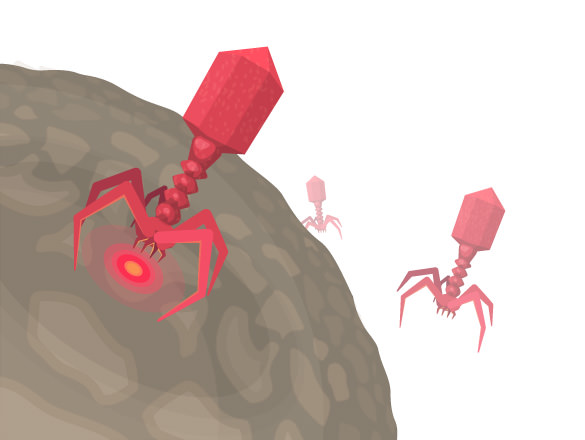7.11 病毒分类
章节大纲
-
How are viruses classified?
::病毒如何分类?In part by their shape. This picture represents a bacteriophage , a that infects . Notice the distinctive shape. This virus has a complex shape.
::部分按其形状。 这幅图片代表一种细菌, 一种感染的细菌。 注意独特的形状。 这个病毒的形状很复杂 。Classification of Viruses
::病毒分类Like the systems for cellular organisms , virus classification is the subject of ongoing debate. This is largely due to the nature of viruses, which are not living organisms by the classic definition, but neither are they necessarily non-living. Therefore, viruses do not fit neatly into the biological classification system of cellular organisms, as plants and do.
::与细胞生物系统一样,病毒分类也是持续争论的主题。 这主要是由于病毒的性质,病毒不是传统定义意义上的活生物体,但也不是非活生物体。 因此,病毒并不像植物和植物那样完全适合细胞生物分类系统。Virus classification is based mainly on characteristics of the viral particles, including the capsid shape, the type of ( or , double stranded (ds) or single stranded (ss)) within the capsid, the process of replication, their host organisms, or the type of disease they cause. The Table lists characteristics such as capsid shape, presence of an envelope, and the diseases the viruses can cause.
::病毒的分类主要基于病毒粒子的特性,包括胶状形状、封盖内(或双倍受困(ds)或单倍受困(ss))的类型、复制过程、宿主有机体或其引起的疾病类型。表格列出了封状形状、信封存在和病毒可能造成的疾病等特征。Viruses Virus Family Virus Envelope Capsid shape Nucleic Acid Disease Adenoviruses Adenovirus No Icosahedral dsDNA upper respiratory infections Parvoviruses Parvovirus No Icosahedral ssDNA fifth disease, Canine parvovirus Herpesviruses Herpes simplex virus, Varicella zoster virus, Epstein Barr virus Yes Icosahedral dsDNA Herpes, chicken pox, shingles, infectious mononucleosis Hepadnaviruses Hepatitis B virus Yes Icosahedral dsDNA Hepatitis B Reoviruses Rotavirus No Icosahedral dsRNA gastroenteritis Retroviruses , HTLV-I Yes Complex ssRNA , leukemia Orthomyxoviruses Influenza viruses Yes Helical ssRNA Influenza (flu) Rhabdoviruses Rabies virus Yes Helical ssRNA Rabies Coronaviruses Corona virus Yes Complex ssRNA Common cold, Severe acute respiratory syndrome (SARS) Cystoviruses Cystovirus Yes Icosahedral dsRNA Infects Pseudomonas bacteria Summary
::摘要-
Viruses can be classified on the basis of capsid shape, presence or absence of an envelope, and type of nucleic acid.
::病毒可依据封状形状、是否存在信封和核酸类型进行分类。
Review
::回顾-
Describe how viruses are classified.
::说明病毒是如何分类的。 -
What is the difference between viruses in the Herpesvirus family and the Retrovirus family?
::赫卑斯病毒家族和逆转录病毒家族的病毒有什么区别? -
What are the four types of nucleic acid that may be present in a virus?
::病毒中可能存在哪四种核酸? -
Give an example of a disease caused by a member of the Orthomyxoviruses.
::举个例子来说明由矫形菌病毒成员引起的疾病。 -
Give an example of a disease caused by a retrovirus.
::举一个反转录病毒引起的疾病的例子。
-
Viruses can be classified on the basis of capsid shape, presence or absence of an envelope, and type of nucleic acid.
